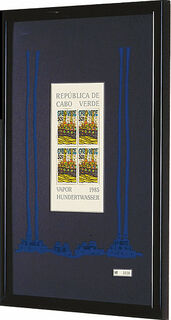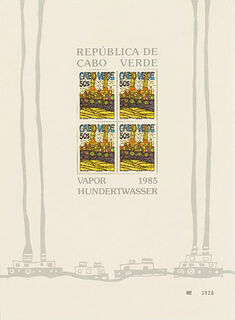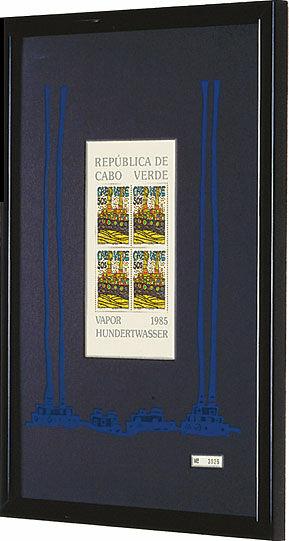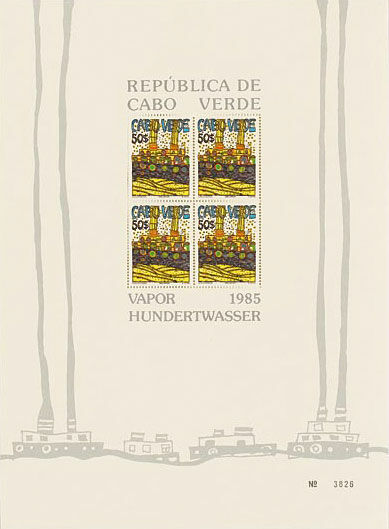Picture "Vapor - The Cabo Verde Steamer". Special edition with 4 stamps à 50 Escudos, blue
Picture "Vapor - The Cabo Verde Steamer". Special edition with 4 stamps à 50 Escudos, blue
Quick info
limited, 10,000 copies | numbered | framed | passe-partout | glazed | size 35.5 x 26.5 cm (h/w)
Delivery time: Immediately deliverable
Detailed description
Picture "Vapor - The Cabo Verde Steamer". Special edition with 4 stamps à 50 Escudos, blue
In 1973, for the first time, Hundertwasser visited Cape Verde, a group of 16 volcanic islands 600 km off the western tip of Africa. The island state, which was still under Portuguese authority at the time, became independent 2 years later.
1982-1985 Hundertwasser created the stamp edition for the new state of Cape Verde. With the finest lines, Hundertwasser's watercolour design 770 was engraved into a steel plate and realised in three colour variations for the 50 Escudos special block issue. The steel engraving process, which is rarely used today, is particularly suitable for small depictions.
The three colour variants of "Vapor" were printed in a limited edition of 10,000 copies each by the Austrian State Printing Office. Size 26 x 19 cm (h/w), individually numbered. We deliver the print in a lavish object frame with a matt black bevel cut passe-partout, which was embossed blue by hand to match the motif. The numbering is visible through a window in the passe-partout. Framed in a black solid varnished wood, dustproof glazing. Size 35.5 x 26.5 cm (h/w).
Customer reviews
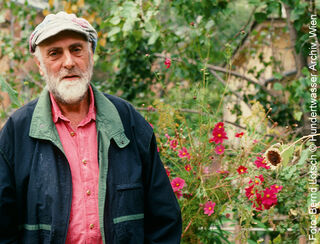
About Friedensreich Hundertwasser
1928-2000
Hundertwasser is one of the most internationally renowned artists of our time. His worldwide reputation was already established in the 1960s. Followed by an eventful and evocative career. His aura and power emerged from his painting and multifaceted work.
Organizing demonstrations, speeches, happenings and campaigns, addressing ecological issues, advocating a life in harmony with nature, manifestos for nature, standing up for a more humane architecture and the improvement of people's lives.
Hundertwasser originated projects such as the tree tenants, the roof afforestation, the regreening of cities, the humus toilet, the restoration of social values and the natural cycles. He was an admonisher against environmental pollution, against the dangers of nuclear energy, against natural degradation and the destruction of natural heritage, and in favour of a waste-free society.
Hundertwasser has been engaged with architecture since the 1950s. On the occasion of the inauguration of the Hundertwasser House of the City of Vienna (1986), he said: "We are again experiencing a turning point where old and rigid values in architecture and urban developement are increasingly being questioned. The straightness and uniformity of Bauhaus architecture is coming to an end because it is callous, sterile, cold, heartless, aggressive and emotionless. The era of absolute rationalism is coming to an end. The new values are enhanced quality of life, not standard of living. Longing for romance, individuality, creativity, especially creativity and living in harmony with nature."
With Friedensreich Hundertwasser, our epoch has found the most imposing challenger of totalitarian thinking, whether it concerns nuclear energy, genetic manipulation, environmental protection or the design of our living space. Hundertwasser lived completely in harmony with his view of things and opposing the contradictions of post-industrial society. Hundertwasser's significance is his art that produces beauty: a message of natural harmony, peace and joy.
The field of graphic arts, that includes artistic representations, which are reproduced by various printing techniques.
Printmaking techniques include woodcuts, copperplate engraving, etching, lithography, serigraphy.

